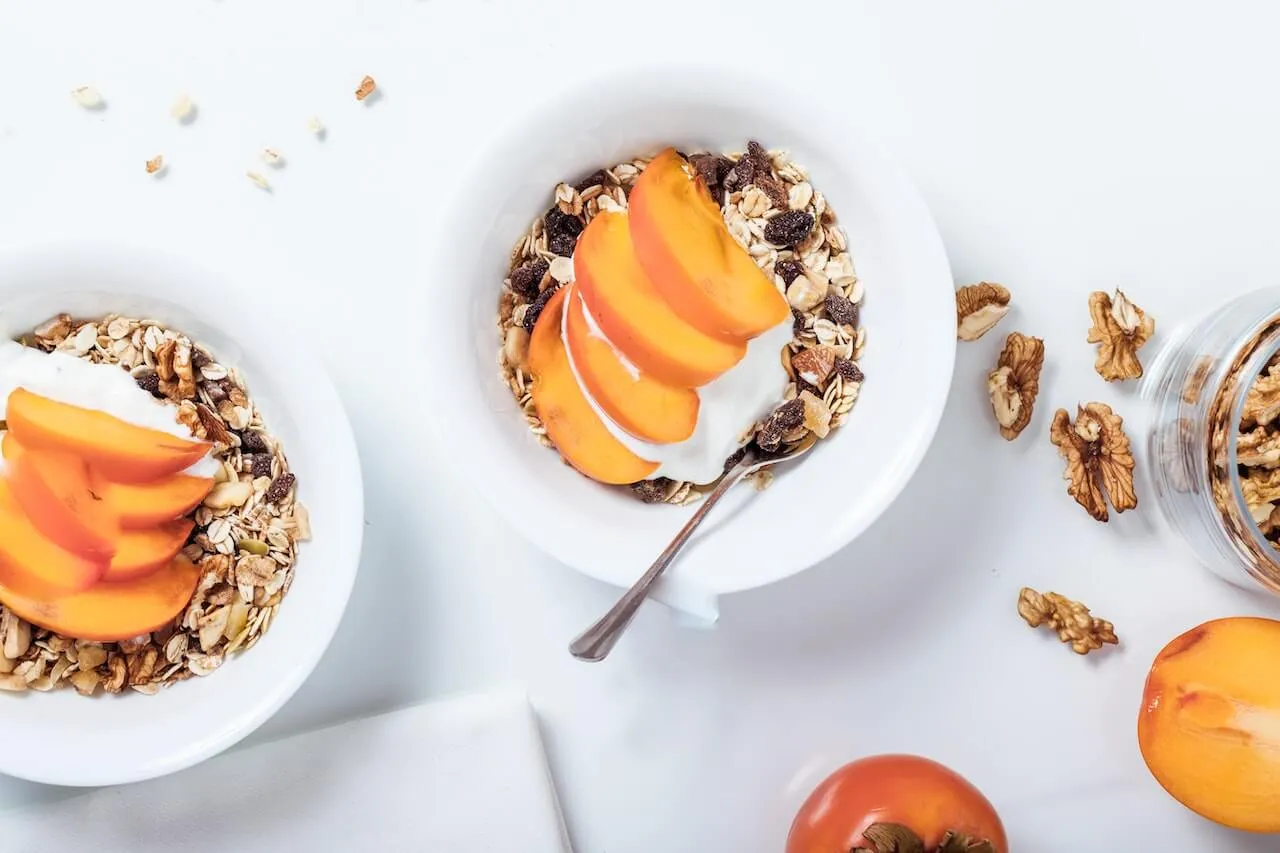Foods with a low glycemic index score raise blood glucose less than foods with a high glycemic index. Including more of these blood sugar-friendly veggies supports a healthy weight and is linked to a lower risk of many chronic diseases.
Here we share some of the best low GI veggies options. Keep in mind that each person can have slightly different responses to foods. GI scores are based on research on healthy people without any blood sugar balance issues, so it’s helpful to test the food (and even different portion sizes) with a continuous glucose monitor (CGM) to see how your body responds.
High-Fiber, Low-Glycemic Vegetables
Raw carrots

Here's the nutritional info for one large carrot:
- Fiber: 2 grams
- Protein: 0.5 grams
- Carbs: 7 grams
- Fat: 0 grams
- Glycemic index of raw carrots (1-100): 35
- Nutritional benefits: Contains vitamin A, potassium, and antioxidants.
- Most glucose-friendly way to consume: Raw carrots are lower GI than cooked carrots.
- Use as a substitute for: Crackers or chips and dip.
- Pair with: Dip into guacamole as a blood-sugar friendly snack.
Artichokes

Here’s the nutritional info for one medium artichoke:
- Fiber: 7 grams
- Protein: 4 grams
- Carbs: 13 grams
- Fat: 0 grams
- Glycemic index of artichokes (1-100): 32
- Nutritional benefits: Contains magnesium, vitamin C, and potassium.
- Most glucose-friendly way to consume: Steam or bake and eat as an easy appetizer.
- Use as a substitute for: High carb apps like chips or breadsticks.
- Pair with: Avocado-oil mayo or aioli.
Asparagus

Here’s the nutritional info for one cup of asparagus:
- Fiber: 3 grams
- Protein: 3 grams
- Carbs: 5 grams
- Fat: 0 grams
- Glycemic index of asparagus (1-100): 32
- Nutritional benefits: Contains vitamin A, folate, and vitamin C.
- Most glucose-friendly way to consume: Steam or bake with olive oil (and parmesan for an extra treat).
- Use as a substitute for: High glycemic side dishes.
- Pair with: Lean protein and low glycemic carbs for a complete meal.
{{mid-cta}}
Red Cabbage

Here’s the nutritional info for one cup of shredded cabbage:
- Fiber: 1.5 grams
- Protein: 1 grams
- Carbs: 5 grams
- Fat: 0 grams
- Glycemic index of red cabbage (1-100): 32
- Nutritional benefits: Contains vitamin A and vitamin C.
- Most glucose-friendly way to consume: Raw or sauteed cabbage are both excellent choices.
- Use as a substitute for: Shredded salad option or use the leaves as a wrap for burgers or sandwiches.
- Pair with: Other veggies for a chopped salad, avocado-oil mayo, or olive oil for a healthy version of coleslaw.
Jicama

Here’s the nutritional info for one cup of sliced jicama:
- Fiber: 6 grams
- Protein: 1 grams
- Carbs: 12 grams
- Fat: 0 grams
- Glycemic index of jicama (1-100): 17
- Nutritional benefits:Contains vitamin C, folate, very high in fiber.
- Most glucose-friendly way to consume: Raw or baked.
- Use as a substitute for: Instead of potatoes, try jicama fries.
- Pair with: Can eat raw with guacamole or dips, baked as an appetizer, or side dish with protein like chicken or fish.
<p class="pro-tip"><strong>Learn more about </strong> <a href="/blog/how-potatoes-affect-blood-sugar">how different potato varieties affect blood sugar</a>.</p>
High-Protein, Low-Glycemic Vegetables
Many veggies contain small amounts of protein, but they aren't considered high protein foods. High protein, low glycemic plant-based protein options include beans and legumes.

These foods are high fiber, low GI foods that keep your blood sugar from spiking to keep you satisfied between meals, including:
- Black beans
- Garbanzo beans
- Lentils
- Pinto beans
- Navy beans
- Kidney beans
- Pinto beans
<p class="pro-tip">Read: 9 Best Vegan Protein Options</p>
High-Carb, Low-Glycemic Vegetables
Sweet potatoes

Here is the nutritional info for a medium boiled sweet potato:
- Carbs: 27 g
- Protein: 2 g
- Fiber: 4 g
- Fat: 0 g
- Glycemic index of sweet potatoes (1-100): 46
- Nutritional benefits: Contains vitamin A, vitamin C, and potassium.
- Most glucose-friendly way to consume: Boiled
- Use as a substitute for: Mashed potatoes
- Pair with: Lean protein like chicken or make a sweet potato sloppy joe.
Corn

Here is the nutritional info for one medium ear of yellow corn:
- Carbs: 19 grams
- Protein: 3 grams
- Fiber: 2 grams
- Fat: 0 grams
- Glycemic index of corn (1-100): 52
- Nutritional benefits: Contains vitamin A, vitamin C, and magnesium.
- Most glucose-friendly way to consume: Boiled or steamed
- Use as a substitute for: A higher-GI side dish.
- Pair with: Make a healthy BBQ with grilled corn and turkey burgers served over greens instead of on a bun.
<p class="pro-tip"><strong>Learn more about </strong> <a href="/blog/corn-blood-sugar-weight-loss">corn, blood sugar and weight loss</a>.</p>
Butternut Squash

Here is the nutritional info for one cup of cooked and cubed butternut squash:
- Carbs: 22 grams
- Protein: 2 grams
- Fiber: 7 grams
- Fat: 0 grams
- Glycemic index of butternut squash (1-100): 51
- Nutritional benefits: Contain vitamin A, vitamin C, and B vitamins.
- Most glucose-friendly way to consume: Boiled or baked
- Use as a substitute for: Mashed butternut squash instead of mashed potatoes.
- Pair with: Add some butter and protein for an even smaller glucose spike.
High-Fat, Low-Glycemic Vegetables
There are several high-fat, low-glycemic foods that are actually fruit (because they contain seeds), but many people call them vegetables.
Avocado

Here is the nutrition info for ½ cup sliced avocado:
- Fat: 11 grams
- Protein: 1.5 grams
- Fiber: 5 grams
- Carbs: 6.5 grams
- Glycemic index of avocados (1-100): 40
- Nutritional benefits: Heart-healthy fat, vitamin E, magnesium, and folate.
- Most glucose-friendly way to consume: However you like them! Sliced, mashed, or cubed.
- Use as a substitute for: You can use avocado as a spread or a side dish to support blood sugar.
- Pair with: Eggs, sprouted bread, even added to protein for an extra dose of nutrients.
Olives

Here is the nutrition info for 5 green olives:
- Fat: 3 grams
- Protein: Less than 1 gram
- Fiber: Less than 1 gram
- Carbs: Less than 1 gram
- Glycemic index of olives: Low (since it’s so low in carbs, there is no established GI and likely won’t affect blood sugar).
- Nutritional benefits: Heart-healthy fat, antioxidants, vitamin E.
- Most glucose-friendly way to consume: However you like them! You can eat the whole fruit or as olive oil.
- Use as a substitute for: Choose olives as your easy, on-the-go snack or as a dip.
- Pair with: You can pair olives with carbohydrates because the fat offsets the glycemic spike.
<div class="pro-tip">Related reading: <ul><li>9 Best Vegan Protein Options</li><li>Low-Glycemic Fruits</li><li>Colors of Fruits and Vegetables</li></ul></div>
FAQs
What does low glycemic mean?
Low glycemic means that a food won’t cause your blood sugar to spike. The glycemic index is a scale of 0-100 that ranks carbohydrates based on how they affect your blood sugar levels.
Although individual responses can be different, foods with a lower score tend to raise your blood sugar more slowly than foods with a higher score. To keep your blood sugar levels stable, you can choose to eat mostly foods low on the glycemic index.
How does the preparation method affect blood sugar levels?
The preparation method of food can affect blood sugar levels because different methods of preparing food can alter the glycemic index (GI) of a food. Some methods of preparing food (such as boiling) can reduce the GI of a food, while other methods (such as frying) can increase the GI of a food and raise glucose faster.
<p class="pro-tip"><strong>Keep reading about </strong> <a href="/blog/vegetables-metabolic-health">the top 12 vegetables for metabolic health</a>.</p>




.svg)










.svg)
.svg)
.svg)
.svg)
.svg)
.svg)
.svg)
